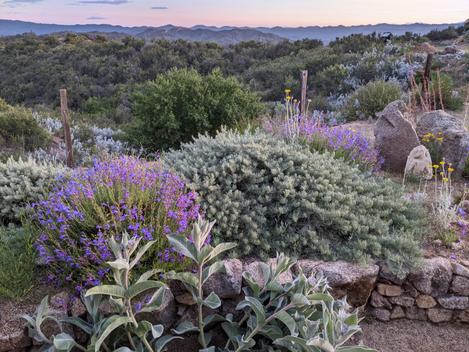Plants For Chaparral

Whiteleaf manzanita, Arctostaphylos viscida, grows from Kern County north to about the Oregon Border. It is not very garden tolerant but easily grown in native gardens. In the Sierra Nevada it is a c... Learn more.

A 6', gray foliage, red trunk and stems, a very clean and neat 'reserved' plant with red-brown bark. This manzanita grows in the Arroyo Grande, San Luis Obispo, and Avila area on sandstone, and sand o... Learn more.

The Blue Corgi is a compact and short round, Big Berry manzanita. The original plant was selected by Bert Wilson in an extremely harsh location in San Benito county. The fifty year old bushes there on... Learn more.

Short lived perennial. A very thorny plant that is nearly unweedable. Why do we grow it? It has 3" white flowers much like Matilija poppy and is excellent in desert gardens or mountain sites. We don'... Learn more.

California Dutchman's Pipe or Pipe Vine is a deciduous vine with one inch purple striped pipe-shaped flowers. Pipe vine likes part-shade. This California native vine has become fairly drought tolerant... Learn more.

California sagebrush, Artemisia californica is an evergray shrub, three to four foot high. This sage brush is native to much of Central and Southern California and is part of the 'sage' in coastal... Learn more.

Artemisia californica ' Canyon Gray', is a low spreader. This silver ground cover is drought tolerant and deer resistant. Leaves are also fragrant. It can be less than 1ft high and about 4ft across. ... Learn more.

California Mugwort, Artemisia douglasiana, is a three foot perennial that has a funny sage odor. Native on stream banks, ditch banks, road cuts or other disturbed areas. Very useful for creek b... Learn more.

(Syn. Artemisia dracunculoides, Artemisia glauca) Tarragon (probably not the variety called French Tarragon, the culinary herb) is a very unattractive weed of disturbed places. Worldwide, maybe native... Learn more.

Artemisia ludoviciana, White Sagebrush is a rhizomatous perennial native from Baja to Ontario Canada and down to Arkansas. I've only seen it once in the wild and that was at 5500 feet in the San Jacin... Learn more.

Asclepias californica, California milkweed is one of the most beautiful milkweeds in California. It has deep purple flowers and almost white gray fuzzy foliage. It is very drought tolerant even occrui... Learn more.

Asclepias eriocarpa, California Monarch Milkweed is a prennial, 3ft large 5in leaves, fruits 4in horns, flowers compound 4-5inch cluster. In our area covered with monarch caterpillars during the summ... Learn more.

California's narrow-leaved Milkweed has narrow leaves and a wider native range and a whole lot more garden tolerance than most of the other native species. Asclepias fascicularis is a perennial wit... Learn more.

A gray-green sprawling perennial that grows along the east edge of the San Joaquin Valley. One of the milkweeds that are used by the butterflies as a food source. Poisonous to cattle, horses and peopl... Learn more.

Baccharis pilularis consanguinea, Coyote Brush, is usually deer proof throughout California. (You might want to cover it for the first year.) It's drought tolerant, very useful for hedges or fence li... Learn more.

A fast growing shrub(it losses its leaves but looks evergreen, like a broom plant). Very colorful yellow flowers make a great show in summer. Use for stream bank stabilization in S. California. It wil... Learn more.

Golden stars are perennial corms with many yellow flowers attached at a central point on top of a tall stem. The structure resembles a dandelion head. Golden stars can be found in clay and serpentine... Learn more.

Corm, 2 ft., flowers yellow in cluster (like exploding fire works), April-June, South coast ranges, Channel Islands, drought tolerant, we carry this only occasionally. Learn more.

Cane Bluestem, Plumed Beard-Grass. Native from San Diego to Santa Barbara east to Oklahoma and down into the tropics. Rather ugly and best used as a limited ingredient in seed mixes. Syn. Andropogon... Learn more.

Brickellbush is one of the best smelling California native plants. Plant this nondescript gray plant in an obscure back corner of your yard. Do not put in a highly visible area. Although Brickellbus... Learn more.

Corms, 1' in height, blue 1" flowers, spring, throughout Ca.,UT, Nev,Ariz.,tolerates most conditions with good drainage, little water after established. Butterfly plant. One of the earlier wildflowers... Learn more.

We occasionally grow this species. Plants with bulbs and linear leaves, in the lily family, grows best in partly shady, mostly clay to lighter granitic soils in the central western portion of the Cal... Learn more.

Bulbs. 1', flowers like tulip, yellow, purple to white, part shade to full sun, no summer water, in most of Ca. perfect drainage. It takes 3-5 years from seed to grow the bulb up to salable size. Ever... Learn more.

Native throughout much of San Diego Co.. In De Luz it is under Adenostoma fasciculatum and Rhus ovata, in the Jamul area it is mixed with Juniperus calif. and Keckiella ternata. Calochortus are not fo... Learn more.
Annual, low, spreading stems or flat to the ground, leaves in a basal rosette, flowers minute, in sandy, open areas, coast, chaparral, desert, forest. disappears after flowering. sSN, Teh, sSnJV, SCoR... Learn more.


